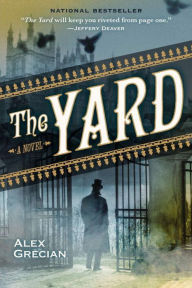 There are times when, as a reader, circumstances converge in the most interesting ways. Since seeing the television adaptation of And Then There Were None last month (my favorite Agatha Christie novel and probably my favorite murder mystery of all time as well), I’ve been on a mystery kick. I’ve also recently been busy getting interested in the television show Penny Dreadful, so when I happened upon a murder mystery set in Victorian London in the wake of the Jack the Ripper murders, I was primed to enjoy the book. But I think my enjoyment of Alex Grecian’s The Yard, goes beyond the fact that I came upon it at a time when my interests happened to converge in just the right way; beyond the mystery itself, The Yard explores an intriguing set of characters at a point in history when so much was changing in terms of the criminal justice system—from the technologies used to catch the criminals to the way metropolitan police systems were organized.
There are times when, as a reader, circumstances converge in the most interesting ways. Since seeing the television adaptation of And Then There Were None last month (my favorite Agatha Christie novel and probably my favorite murder mystery of all time as well), I’ve been on a mystery kick. I’ve also recently been busy getting interested in the television show Penny Dreadful, so when I happened upon a murder mystery set in Victorian London in the wake of the Jack the Ripper murders, I was primed to enjoy the book. But I think my enjoyment of Alex Grecian’s The Yard, goes beyond the fact that I came upon it at a time when my interests happened to converge in just the right way; beyond the mystery itself, The Yard explores an intriguing set of characters at a point in history when so much was changing in terms of the criminal justice system—from the technologies used to catch the criminals to the way metropolitan police systems were organized.
The London police are still reeling from their failure to catch Jack the Ripper and it appears they may be more directly under attack when the body of one of their men—Inspector Christian Little—turns up stuffed into a trunk at a train station. The case falls into the hands of Inspector Walter Day who has just moved to London with his wife and is beginning to question the decision. With the assistance of his fellow inspector Michael Blacker and the unorthodox Dr. Bernard Kingsley who quickly becomes Scotland Yard’s first forensic pathologist, Day works to catch the killer before any more policemen can be killed. In a city like London, though, beat cops like Nevil Hammersmith already know all too well just how many murders and disappearances fall by the wayside and how difficult it can be to pick up a trail when hampered by bureaucracy and apathy.
The Yard is ultimately designed to introduce the core cast of characters and premise for the Scotland Yard Murder Squad series so there are a few narrative twists and turns within the text that can be more misleading and heavy-handed than traditional red herrings but for me the overlapping murders and mysteries ended up coming together beautifully by the novel’s conclusion. Having so many narrative perspectives can be a bit overwhelming and there are some for whom having the central murderer’s perspective throughout (and therefore his identity relatively early on in the story) simply don’t work; I’m not one of those people (I always adored Murder, She Wrote and Columbo equally).
While the narrative focus emphasized Day, Kingsley, and Hammersmith to establish them as the series’ leads, the appearances of Scotland Yard’s new commissioner, Colonel Sir Edward Bradford work to subtly establish the premise and setting of the series before it gets hammered home in the book’s final pages. The structure of the Yard is changing internally as more and more murder cases need specialized attention with the city’s massive population and disparate social strata and Sir Edward is the highest ranking of the outsiders coming into the Yard and encouraging the necessary changes. He welcomes fresh perspectives and appreciates that science is advancing in ways that have the potential to assist in investigation if not always criminals’ conviction when it comes to trials. He recognizes that the nature of crime in the city is changing and that the police force must change in response if they hope to be effective in the role they play upholding the peace and bringing criminals to justice.
It’s an incredibly interesting period in criminal history and I find Grecian’s approach intriguing and one I can’t wait to explore further with the next few books of the series. As I wait for my name to hit the top of my library’s waitlist for the next book, I might just do a little research into some of this organizational and technological changes in the history of criminal justice to see how closely the timelines and origins are reflected in the fictionalized series.